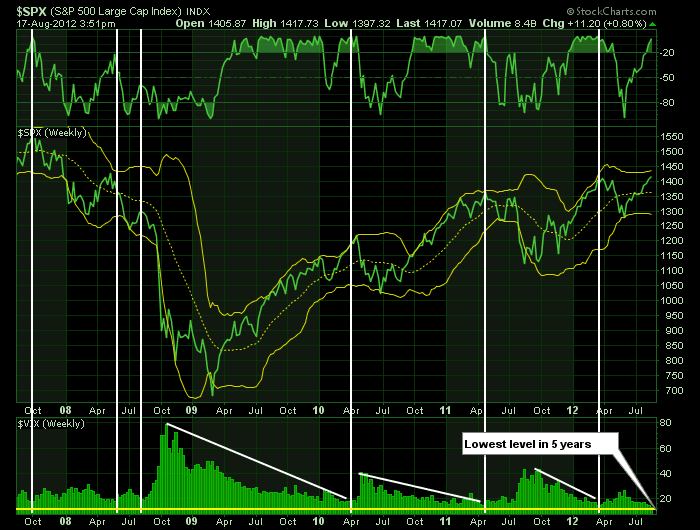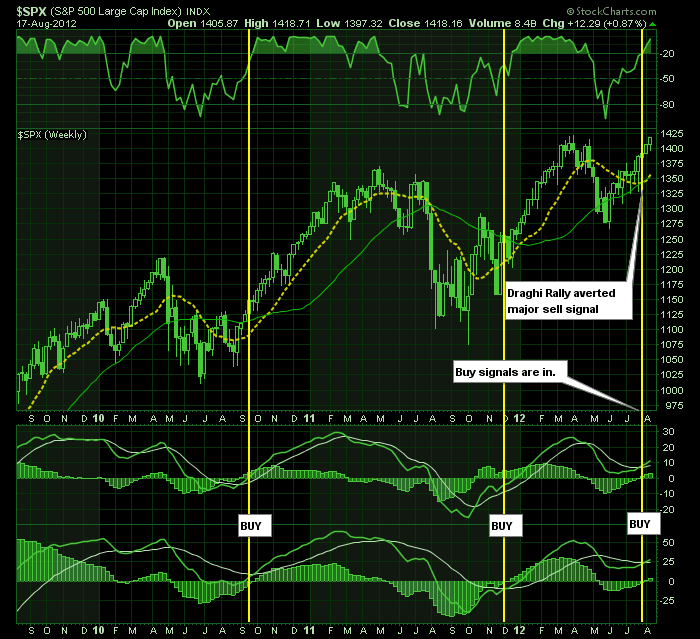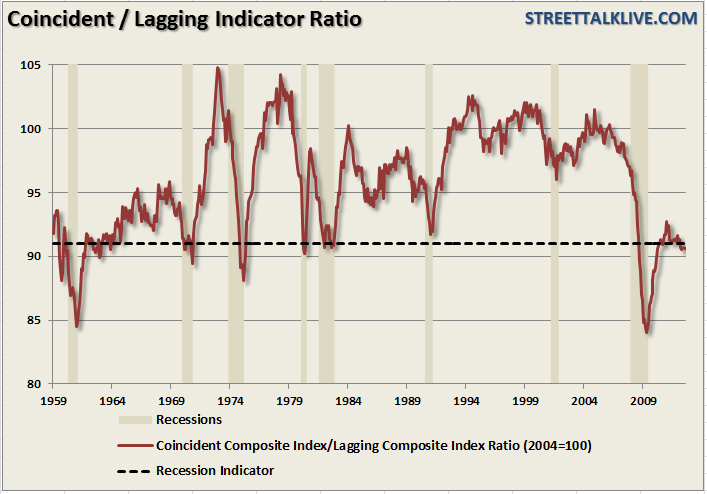There is no doubt that the market rally in July and August has been far stronger than we predicted back in June. Yet, that rally has not been based on an improving fundamental backdrop as revenue growth has deteriorated sharply over the last few quarters. Furthermore, while bottom line earnings did not contract as much as earlier feared, after handy accounting gimmickry, growth has fallen to just 2% while earnings' multiples expanded by 1.5 points. This is a very similar setup to the market peak last year. Furthermore, while 70% of companies beat their estimates in the latest reporting period those estimates had to be sharply lowered to be beaten. The quality of the reporting was very poor, guidance was decidedly negative and revenue growth disappeared.
The economic backdrop is likewise showing signs of weakness. The majority of regional manufacturing indexes have slipped into contractionary territory as of late with an unwanted build in inventories as end demand slows. Consumer sentiment indexes remain mired at recessionary levels which is not surprising given the weakness in employment and stagnant wages. The spike in food, gasoline and oil prices are going to be a bigger drain on the economy than currently believed. The last time we had this combination of events was in the first quarter of 2011 and it produced a near zero percent GDP growth rate.
Europe remains a mess with Greece needing a 2-yr extension on "austerity measures" even as they need more bailout dollars, bad loans in Spain just hit their highest level ever, and Italy is going to need a bailout soon.
Yet, investors have decided to vote for "hope." Over the last two months market indexes have moved higher based on the resilient belief that the Federal Reserve, and the ECB, will continue to pump dollars into the system to keep it afloat. They are likely right.
However, this brings two questions to the fore: 1) When will such interventions most likely occur; and 2) what should investors do?
The answer to the first question is fairly easy. With the markets near their highs for the year, the economic data soft but not recessionary at the moment, and unemployment claims declining it is very unlikely that the Fed will not act with a third round of Quantitative Easing at the next FOMC meeting in September. My best guess, is that he will choose to conserve that "ammo" until the economy is reflecting a much higher risk of a recessionary drag or systemic risk.
The EU is another discussion entirely and there are many surrounding when further "bailouts" will occur. While Draghi and Merkel have both voiced their determination to save the Eurozone - they are miles apart from an agreement or method. Draghi wants to use EFSF and ESM funds to bailout banks with few, or no, conditions whereas Merkel is saying that conditions must be met first. This is a huge roadblock that may be very tough to navigate before the next crisis in the Eurozone arises.
The reality is that governments around the world will continue their efforts to bailout, support and defend against the threat of another systemic financial crisis. However, what this means for investors is that markets racked with volatility will continue.
The second question also has a fairly simple answer - it is just the implementation that is difficult. The markets are currently extremely overbought on an intermediate basis with volatility at 5 year lows. The chart shows the S&P 500 index currently trading at near 2-standard deviations on a weekly basis and very overbought. The Volatility Index at the bottom is now sitting at levels more often associated with market tops rather than the beginning of new advances.
At the same time the weekly market "buy" signals have now reversed from their "sell" conditions in April. This implies that equity exposure should be increased in portfolios. However, this is where the "difficult" part occurs for investors - it's the waiting. When markets are rising, even on the basis of "hope", the emotional pull of "getting in" is overwhelming for most investors. This is why most investors buy at the top and sell at the bottom. It is the waiting for an entry point to put capital at risk that is difficult.
The chart shows our weekly "buy" indicators over the last three years. Historically, the "buy" signals have occurred as the markets came off of a bottom closer to the beginning of the advance. Furthermore, the volatility index (VIX) was at high levels and falling. 
Currently, the "buy" signal is occurring well into the advance with the VIX at levels more indicative of the end of an advance rather than the beginning of one. This set up makes an entry into the markets at these levels fraught with risk. Waiting for a pullback will provide a more strategic entry with less principal risk.
Currently, a correction to previous levels of support will provide a better risk/reward entry point by reversing overbought conditions. The two most likely targets currently are 1360 and 1300. Any pullback to these areas, likely due to disappointment with the Fed not implementing QE in September, will provide a more opportune entry point to increase equity exposure for the seasonally strong period in the fall.
Plenty Of Worries
There is more than sufficient evidence that investors should be more cautious from a technical and fundamental basis. Investors are currently setting themselves up for real trouble by chasing yield. With yield spreads currently at levels that are more indicative of economic problems - it increases risk of principal loss in "high yield" bonds and bond funds.
Likewise, the release of Leading Economic Indicators showed two major concerns. The first is that even with a sharp market advance, falling unemployment claims and strengthening housing permits - the index was only able to eek out a tiny gain from 95.4 last month to 95.8 in August. Furthermore, the year-over-year growth rate of the index has now fallen to 1.48% from 9.95% in March. While declines of this magnitude do not immediately imply a recessionary contraction and sharp decline in stocks - it does indicate that the current cyclical bull market may be closer to maturity. 
Furthermore, the coincident-to-lagging indicator ratio, which is like a book-to-bill for the overall economy, has remain mired at levels which has always been indicative of recessions. Of course, in the past there has never been as much artificial intervention as there is today. However, whether we are "technically" or "statistically" in a recession is not the real issue. The reality is that consumers and businesses are behaving as if a recession was in play. That defensive behavior will continue to result in stagnant employment, weaker consumption trends and slower revenue growth.
Discipline And Patience
With the S&P 500 now migrating to the high end of its 52-week range it has done so with volume and breadth that is lacking, negative divergences in many of the underlying indicators and an erratic sector rotation that is more indicative of market tops than not. With little real news out of Europe and virtual vacuum of activity in the markets - stocks have floated higher in recent weeks.
Our "buy" signals are back online but the setup is very poor on a risk/reward basis. The markets will give us an opportunity to increase equity exposure in the coming weeks ahead. Be patient for now, create your buy list and be ready for the next opportunity. When it comes it will likely not be here for long. Being disciplined and patient in your investing process will lead to longer term success. A professional gambler understands the risk of winning or losing any potential hand and weighs that against the capital risk. There is no difference when investing - when managing risk it means that you may not catch every little uptick in the market. However, making up a missed opportunity is easy - it is the making up of lost capital that is difficult.
- English (UK)
- English (India)
- English (Canada)
- English (Australia)
- English (South Africa)
- English (Philippines)
- English (Nigeria)
- Deutsch
- Español (España)
- Español (México)
- Français
- Italiano
- Nederlands
- Português (Portugal)
- Polski
- Português (Brasil)
- Русский
- Türkçe
- العربية
- Ελληνικά
- Svenska
- Suomi
- עברית
- 日本語
- 한국어
- 简体中文
- 繁體中文
- Bahasa Indonesia
- Bahasa Melayu
- ไทย
- Tiếng Việt
- हिंदी
Thoughts On The Market: Don't Chase Yield
Published 08/19/2012, 01:26 AM
Updated 02/15/2024, 03:10 AM
Thoughts On The Market: Don't Chase Yield
3rd party Ad. Not an offer or recommendation by Investing.com. See disclosure here or
remove ads
.
Latest comments
Install Our App
Risk Disclosure: Trading in financial instruments and/or cryptocurrencies involves high risks including the risk of losing some, or all, of your investment amount, and may not be suitable for all investors. Prices of cryptocurrencies are extremely volatile and may be affected by external factors such as financial, regulatory or political events. Trading on margin increases the financial risks.
Before deciding to trade in financial instrument or cryptocurrencies you should be fully informed of the risks and costs associated with trading the financial markets, carefully consider your investment objectives, level of experience, and risk appetite, and seek professional advice where needed.
Fusion Media would like to remind you that the data contained in this website is not necessarily real-time nor accurate. The data and prices on the website are not necessarily provided by any market or exchange, but may be provided by market makers, and so prices may not be accurate and may differ from the actual price at any given market, meaning prices are indicative and not appropriate for trading purposes. Fusion Media and any provider of the data contained in this website will not accept liability for any loss or damage as a result of your trading, or your reliance on the information contained within this website.
It is prohibited to use, store, reproduce, display, modify, transmit or distribute the data contained in this website without the explicit prior written permission of Fusion Media and/or the data provider. All intellectual property rights are reserved by the providers and/or the exchange providing the data contained in this website.
Fusion Media may be compensated by the advertisers that appear on the website, based on your interaction with the advertisements or advertisers.
Before deciding to trade in financial instrument or cryptocurrencies you should be fully informed of the risks and costs associated with trading the financial markets, carefully consider your investment objectives, level of experience, and risk appetite, and seek professional advice where needed.
Fusion Media would like to remind you that the data contained in this website is not necessarily real-time nor accurate. The data and prices on the website are not necessarily provided by any market or exchange, but may be provided by market makers, and so prices may not be accurate and may differ from the actual price at any given market, meaning prices are indicative and not appropriate for trading purposes. Fusion Media and any provider of the data contained in this website will not accept liability for any loss or damage as a result of your trading, or your reliance on the information contained within this website.
It is prohibited to use, store, reproduce, display, modify, transmit or distribute the data contained in this website without the explicit prior written permission of Fusion Media and/or the data provider. All intellectual property rights are reserved by the providers and/or the exchange providing the data contained in this website.
Fusion Media may be compensated by the advertisers that appear on the website, based on your interaction with the advertisements or advertisers.
© 2007-2024 - Fusion Media Limited. All Rights Reserved.
